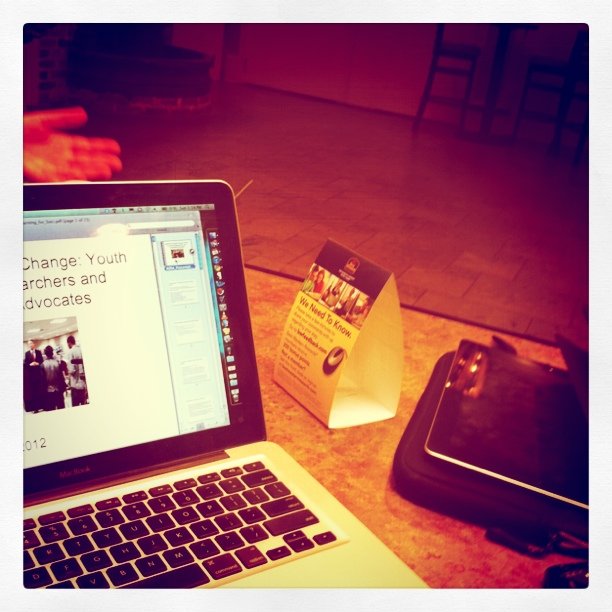
After a couple of days to recover, I wanted to share a few thoughts on another AERA conference. Though they do not represent everything I saw within the conference, I think they speak directly to what needs to be improved.
Lack of twitter
While I didn’t expect a twitter feed as lively as #dml2011, I was disappointed by the lack of engagement with the not-so-new medium. With nearly 15,000 people and the usual phone-book sized directory of sessions, Twitter is an ideal way to personalize the conference experience, engage in networking, and collaborate. Competing hashtags, a lack of free wifi & spotty service in the main hotels, and a limited number of tweeters made the conference generally disappointing in terms of social networking. One person tallied roughly 20-25 attendees (total) were contributing tweets from the conference.
And having a mobile app that does little more than act as a clunkier version of a directory doesn’t bring AERA any closer to connecting to a “social imagination.”
The problem with CHAT
The problem with CHAT isn’t really a CHAT problem at all. Instead, it is much more a problem of depersonalization and decontextualization of the research at AERA. I described AERA to several people as a giant five-day show-and-tell. While there is meaningful research being contributed, what happens as a result of AERA? More directly: we have 15,000 experts in the same place, at the same time, and all largely wanting to engage in conversations about education; why can’t AERA be productive, active, and responsive?
And so, I found myself participating in a working group that largely revolved around discussing CHAT-related sessions at the conference. Don’t get me wrong, when I understand CHAT, I find it really interesting. I’ve described it this way to a friend recently: “CHAT is a theory about everything and nothing. It’s kind of like the Seinfeld of learning theory.” In any case, geometry has never been my strong suit, and a conversation about CHAT eventually devolves into a conversation about triangles (literally). I couldn’t help but feel the tension of having flown across the country to engage in dialogue with the best of academic researchers only to have this be a conversation about triangles.
[btw, I’m amazed there is no wikipedia entry for CHAT … get some grad student to get on that!]
The “It’s so nice” syndrome
I spent a healthy portion of my time with the UCLA IDEA Council of Youth Research. I can say that they were the true highlight of the conference, representing both cutting edge research and calling those that saw their work to enact change.
However, I heard several conversations throughout the conference that described the research of teachers and students in ways that was tokenizing. Specifically, a conference attendee described hearing students talk in ways that matched current researcher rhetoric. The students were described glowingly and the attendee said it was “so nice” to hear these students speaking so clearly. I’ve been on the side of the discussed students before as well; teachers presenting and interacting at AERA fare little better than students. While the Council argues for students and teacher to be engaged in the process of research, we are still more subject than peer at AERA. It is difficult to imagine a research community that will treat practitioners and youth as legitimate partners if their experiences and voices are not more fully developed within the conference. I’m pretty sure I’ve ranted about this when reflecting on past AERA conferences as well.
Monday morning had one of the best sessions of the entire conference: four different youth-oriented research groups from across the country presented their findings. It was powerful and meaningful work and it was all voiced by high school students and teachers. Of course, it was the only session like this and a morning sessions towards the end of a conference (in New Orleans of all places) didn’t yield record crowds. Yes, it’s a step forward for AERA to have sessions with students, but with this sliver of a door open, it’s time to budge open full swing. How about, instead of a single, round-table session where students are literally competing for audience members, we make this a regular part of the conference. What if sessions had students and teachers as discussants? Or are we not as concerned about relevance when it comes to our work? Summarizing a question Ernest Morrell asked at the end of a session on Saturday, what’s going to be more important at the end of the day: directly interacting in research with teachers and students to improve education, or getting another citation in a peer reviewed journal?
The future and beyond
A non-Council of Youth Research highlight for me was seeing the members of the New London Group discuss what is in store “Beyond New London.” While the academic Lollapalooza was fun, at the end of the day, it left me curious about what’s next. When actually addressing what is “Beyond” in terms of the future of literacies, the group did little more than shrug. Likewise, the working group I was involved in, “Intervening for the Future,” while a useful group for intellectual conversation, puttered more with the concept of intentional intervention; should we or shouldn’t we? Not that I’m thrilled with a book like this, but I do wish AERA had a bit more forward-thinking, on-the-ground engagement at this year’s conference. I do see the research of my colleagues and I as moving beyond New London “stuff,” and the Council provides me with a sense of optimism and possibility for the future, but these are tangential groups and not all mainstream practices within AERA.